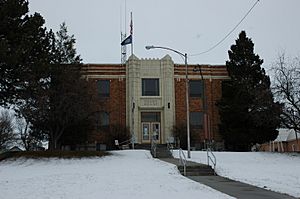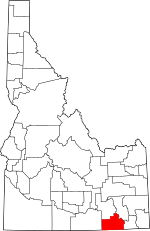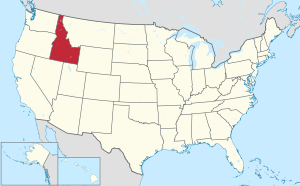Oneida County, Idaho facts for kids
Quick facts for kids
Oneida County
|
||
|---|---|---|

Oneida County Courthouse in Malad City
|
||
|
||

Location within the U.S. state of Idaho
|
||
 Idaho's location within the U.S. |
||
| Country | ||
| State | ||
| Founded | January 22, 1864 | |
| Named for | Oneida Lake, New York | |
| Seat | Malad City | |
| Largest city | Malad City | |
| Area | ||
| • Total | 1,202 sq mi (3,110 km2) | |
| • Land | 1,200 sq mi (3,000 km2) | |
| • Water | 1.5 sq mi (4 km2) 0.1% | |
| Population
(2020)
|
||
| • Total | 4,564 |
|
| • Density | 3.8/sq mi (1.5/km2) | |
| Time zone | UTC−7 (Mountain) | |
| • Summer (DST) | UTC−6 (MDT) | |
| Congressional district | 2nd | |
Oneida County is a county located in the U.S. state of Idaho. As of the 2010 Census the county had a population of 4,286. The county seat and largest city is Malad City. Most of the county's population lives in Malad City and the surrounding Malad Valley.
Contents
History
The county is named for Oneida Lake, New York, the area from which most of the early settlers had emigrated.
Oneida County was organized on January 22, 1864, as the second county organized under Idaho Territory. Its original boundaries were set at the 113th meridian, the Snake River, the 112th Meridian north of the Snake River, the Rocky Mountains, and the southern boundary of Idaho Territory. While older and more populous settlements existed within the boundaries of the new county, the original county seat was established at Soda Springs in present-day Caribou County because those older settlements were believed to be in Utah Territory until the southern boundary of Idaho Territory was surveyed in 1870. The county seat was moved to Malad City in 1866 because of its population growth and location on the freight road and stagecoach line between Corinne, Utah, and the mines in Butte, Montana.
Once among Idaho's largest counties in area and population, a portion was stricken to Dakota Territory in 1864 and additional territory was included in Wyoming Territory at its formation in 1868. Even after Bear Lake County was formed from southeastern Oneida County in 1875, Oneida County managed to be the most populous of Idaho's counties at the 1880 census with a population of 6,964. The county's area was further reduced with the establishment of Bingham County in 1885. A portion was taken to form Franklin and Power counties in 1913.
Geography
According to the U.S. Census Bureau, the county has a total area of 1,202 square miles (3,110 km2), of which 1,200 square miles (3,100 km2) is land and 1.5 square miles (3.9 km2) (0.1%) is water.
Elkhorn Peak is the county's highest point, at 9,095 feet (2,772 m) above sea level. Alternating valleys and ridges of mountains or hills typify the topography, with grassland and sagebrush covering most areas. The Curlew National Grassland lies within the county.
Adjacent counties
- Power County – north
- Bannock County – northeast
- Franklin County – east
- Cache County, Utah – southeast
- Box Elder County, Utah – south
- Cassia County – west
Major highways
National protected areas
- Caribou National Forest (part)
- Curlew National Grassland (part)
- Sawtooth National Forest (part)
Demographics
| Historical population | |||
|---|---|---|---|
| Census | Pop. | %± | |
| 1870 | 1,922 | — | |
| 1880 | 6,964 | 262.3% | |
| 1890 | 6,819 | −2.1% | |
| 1900 | 8,933 | 31.0% | |
| 1910 | 15,170 | 69.8% | |
| 1920 | 6,723 | −55.7% | |
| 1930 | 5,870 | −12.7% | |
| 1940 | 5,417 | −7.7% | |
| 1950 | 4,387 | −19.0% | |
| 1960 | 3,603 | −17.9% | |
| 1970 | 2,864 | −20.5% | |
| 1980 | 3,258 | 13.8% | |
| 1990 | 3,492 | 7.2% | |
| 2000 | 4,125 | 18.1% | |
| 2010 | 4,286 | 3.9% | |
| 2020 | 4,564 | 6.5% | |
| U.S. Decennial Census 1790–1960 1900–1990 1990–2000 2010–2020 2020 |
|||
2010 census
As of the 2010 United States Census, there were 4,286 people, 1,545 households, and 1,161 families living in the county. The population density was 3.6 inhabitants per square mile (1.4/km2). There were 1,906 housing units at an average density of 1.6 per square mile (0.62/km2). The racial makeup of the county was 96.7% white, 0.5% Asian, 0.5% American Indian, 0.2% black or African American, 1.1% from other races, and 1.0% from two or more races. Those of Hispanic or Latino origin made up 2.9% of the population. In terms of ancestry, 38.3% were English, 15.1% were Welsh, 12.8% were "American", 10.7% were German, 5.8% were Swedish, and 5.1% were Danish.
Of the 1,545 households, 36.4% had children under the age of 18 living with them, 65.9% were married couples living together, 6.1% had a female householder with no husband present, 24.9% were non-families, and 22.5% of all households were made up of individuals. The average household size was 2.74 and the average family size was 3.24. The median age was 39.1 years.
The median income for a household in the county was $44,599 and the median income for a family was $51,371. Males had a median income of $43,362 versus $24,821 for females. The per capita income for the county was $17,950. About 11.9% of families and 13.4% of the population were below the poverty line, including 14.2% of those under age 18 and 13.0% of those age 65 or over.
Arts and culture
Museums and other points of interest
Oneida County contains seven buildings listed on the National Register of Historic Places:
- The Co-Op Block and J. N. Ireland Bank, in Malad City
- The D.L. Evans, Sr. Bungalow, in Malad City
- The Jedd Jones House, in Malad City
- The Malad Second Ward Tabernacle, in Malad City
- The Oneida County Courthouse, in Malad City
- The Samaria Historic District, in Samaria
- The United Presbyterian Church, in Malad City
Communities
City
Unincorporated communities
Notable people
- John V. Evans (1925–2014), Governor of Idaho (1977–87); born in Malad City
- William Marion Jardine (1879–1955), U.S. Secretary of Agriculture (1925–29) and the U.S. Ambassador to Egypt; born in Oneida County.
See also
 In Spanish: Condado de Oneida (Idaho) para niños
In Spanish: Condado de Oneida (Idaho) para niños


